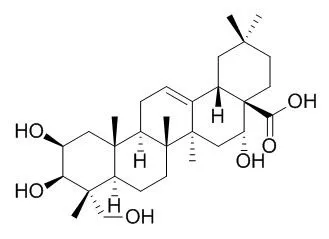| Description: |
Polygalacic acid may exert a significant neuroprotective effect on cognitive impairment, driven in part by the modulation of cholinergic activity and neuroinflammation. Polygalacic acid shows significant postingestive effects on Spodoptera littoralis larvae. |
| Targets: |
AChR | Immunology & Inflammation related |
| In vitro: |
| J Nat Prod. 2010 Nov 29;73(11):1863-7. | | Antiproliferative effects of saponins from the roots of Platycodon grandiflorum on cultured human tumor cells.[Pubmed: 20939516] |
METHODS AND RESULTS:
Three new triterpenoid saponins, platyconic acid B lactone (1), deapio-platyconic acid B lactone (2), and deapio-platycodin D(2) (3), together with 17 known triterpenoid saponins, were isolated from a root extract of Platycodon grandiflorum. The structures of 1-3 were determined on the basis of spectroscopic data interpretation and chemical transformation.
CONCLUSIONS:
Saponins with a platycodigenin or Polygalacic acid unit as a sapogenin demonstrated significant inhibitory effects on the proliferation of a small panel of cultured human tumor cells. | | Phytochemistry. 2011 Jun;72(8):743-51. | | Bioactive saponins from Microsechium helleri and Sicyos bulbosus.[Pubmed: 21439597 ] | Eleven oleanane-type saponins (1-11) have been isolated from Microsechium helleri and Sicyos bulbosus roots and were evaluated for their antifeedant, nematicidal and phytotoxic activities.
METHODS AND RESULTS:
Saponins {3-O-β-D-glucopyranosyl (1→3)-β-D-glucopyranosyl-2β,3β,16α,23-tetrahydroxyolean-12-en-28-oic acid 28-O-α-L-rhamnopyranosyl-(1→3)-β-D-xylopyranosyl-(1→4)-[β-D-xylopyranosyl-(1→3)]-α-L-rhamnopyranosyl-(1→2)-α-L-arabinopyranoside} (1), and {3-O-β-D-glucopyranosyl-2β,3β,16α,23-tetrahydroxyolean-12-en-28-oic acid 28-O-α-L-rhamnopyranosyl-(1→3)-β-D-xylopyranosyl-(1→4)-[β-D-xylopyranosyl-(1→3)]-α-L-rhamnopyranosyl-(1→2)-α-L-arabinopyranoside} (2) were also isolated from M. helleri roots together with the two known compounds 3 and 4. Seven known structurally related saponins (5-11) were isolated from S. bulbosus roots. The structures of these compounds were established as bayogenin and polygalacic glycosides using one- and two-dimensional NMR spectroscopy and mass spectrometry. Compounds 7, 10, bayogenin (12) and Polygalacic acid (13) showed significant (p<0.05) postingestive effects on Spodoptera littoralis larvae, compounds 5-11 and 12 showed variable nematicidal effects on Meloydogyne javanica and all tested saponins had variable phytotoxic effects on several plant species (Lycopersicum esculentum, Lolium perenne and Lactuca sativa).
CONCLUSIONS:
These are promising results in the search for natural pesticides from the Cucurbitaceae family. |
|
| In vivo: |
| Phytomedicine. 2016 Feb 15;23(2):149-55. | | Neuroprotective effects of polygalacic acid on scopolamine-induced memory deficits in mice.[Pubmed: 26926176 ] | Polygala tenuifolia Willd is a Traditional Chinese Medicine used for the treatment of learning and memory deficits.
METHODS AND RESULTS:
Triterpenoid saponins, the main bioactive compounds of Polygala tenuifolia Willd, are easily hydrolyzed to Polygalacic acid (PA).Treatment with scopolamine significantly increased the escape latency time, decreased the number of crossings, and shortened the time spent in the target quadrant, while PA reversed these scopolamine-induced effects. PA significantly improved cholinergic system reactivity, as indicated by decreased acetylcholinesterase (AChE) activity, increased choline acetyltransferase (ChAT) activity, and elevated levels of acetylcholine (ACh) in the hippocampus and frontal cortex. PA also significantly ameliorated neuroinflammation and oxidative stress in mice.
CONCLUSIONS:
These results suggest that PA might exert a significant neuroprotective effect on cognitive impairment, driven in part by the modulation of cholinergic activity and neuroinflammation. |
|






 Cell. 2018 Jan 11;172(1-2):249-261.e12. doi: 10.1016/j.cell.2017.12.019.IF=36.216(2019)
Cell. 2018 Jan 11;172(1-2):249-261.e12. doi: 10.1016/j.cell.2017.12.019.IF=36.216(2019) Cell Metab. 2020 Mar 3;31(3):534-548.e5. doi: 10.1016/j.cmet.2020.01.002.IF=22.415(2019)
Cell Metab. 2020 Mar 3;31(3):534-548.e5. doi: 10.1016/j.cmet.2020.01.002.IF=22.415(2019) Mol Cell. 2017 Nov 16;68(4):673-685.e6. doi: 10.1016/j.molcel.2017.10.022.IF=14.548(2019)
Mol Cell. 2017 Nov 16;68(4):673-685.e6. doi: 10.1016/j.molcel.2017.10.022.IF=14.548(2019)